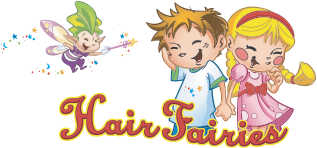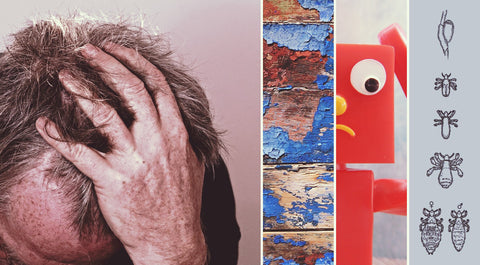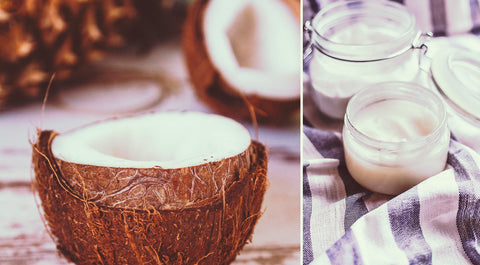Nobody enjoys an itchy scalp. Unless it is a chronic condition, lice are often the first concern when the scalp suddenly begins to itch — particularly if you or your children have been exposed to a recent outbreak at school, in day care, or during some sort of group activity (e.g. summer camp). Because lice are extremely common and contagious, it is important to be able to distinguish between lice, nits, dandruff, and a dry scalp to prevent the unnecessary spreading of lice.
Lice vs. Dandruff & DryScalp
Dandruff (also known as seborrhea dermatitis) affects up to 50% of the general population. It is caused by the excessive production of dead skin cells that itch and become flaky. It is self-contained and cannot be spread to others, though some evidence does suggest dandruff can run in families. Dandruff affects those who have either overly dry or oily scalps, often resulting in scaly skin and white flaky particles visible in the hair. Lice, on the other hand, are highly contagious parasites that look like tiny white bugs. Left untreated, they infest the scalp and cause an irritating itching sensation as they crawl around and lay eggs. Lice often spread quickly and easily because they can crawl from one infected scalp to another through head-to-head contact. In fact, 6-12 million U.S. kids between the ages of 3 and 11 become infected with lice each year.
How to Tell the Difference Between Lice& Dandruff
The quickest way to distinguish between lice and dandruffis that lice don’t just brush out; they adhere to the hair with a cement-like bonding agent and are very difficult to remove without special tools, such as a lice comb. If it brushes out or you can flick it out, it’s likely dandruff.  Note that lice are unable to jump, fly, or swim, and cannot survive in your surrounding environment (furniture, sheets, etc.). There are three forms of lice:
Note that lice are unable to jump, fly, or swim, and cannot survive in your surrounding environment (furniture, sheets, etc.). There are three forms of lice:
- Also known as nits, lice eggs are hard to see and often confused for dandruff or droplets of hair spray. They are small white specks and can be found at the base of the hair shaft.
- When lice eggs hatch, they release nymphs. The shells of hatched lice eggs remain attached to the hair and present as a dull yellow color. The nymphs themselves are tiny and tan-colored, and grow into adults over the course of about a week.
- Adult lice have six legs, each with a claw, and are tan to grayish-white in color. They are no bigger than a sesame seed. Adults multiply quickly, laying up to five eggs per day and living for up to 30 days.

Lice vs. Nits
Covered above, nits (i.e. lice eggs) are typically white, tan, or brown in color and usually attach to individual strands of hair. While adult lice only grow to about the size of a sesame seed, nits are even smaller, resembling microscopic specs in the hair. It is much easier to contain nits prior to them hatching into a full-blown lice infestation. If you or your children have been exposed to a recent lice outbreak, it is highly advisable that you invest in a lice prevention kit. (Even if not, it is beneficial to have one on hand; you never know when an outbreak may happen.)
Buying New Stuff: $$$
Upon discovering lice, you may have an urge to throw away every sheet, towel, and pillow throughout the household in an effort to eradicate lice. You are not alone! We have spoken with hundreds of families over the years who have thrown away perfectly good sheets, towels, pillows, rugs, and even furniture! The best advice we can give is don’t panic! (And don’t throw away perfectly good household items.) Call your local Hair Fairies and we can walk you through the process of getting rid of lice and nits without moving everything to the curbside bin.
Missed Work: $$$$
Can’t find a sitter? Family and friends not particularly thrilled about the prospect of looking over your lice-infested child while you head off to work? Sounds like a missed day at the office! Those of us with school-aged children know how hard it is to balance teacher planning days, holidays, sick days, and inconsistent school schedules with busy work schedules. It requires a lot of understanding by the boss and your fellow coworkers. For that reason, unplanned days off due to a lice outbreak can be especially stressful for working parents. Not to mention the lost pay or vacation days spent staying home.
The Alternative
Professional Lice Removal: $85
For $85 per hour, a professional Hair Fairies specialist can comb through the hair, meticulously picking out each nit and removing lice completely – often in a single session! Also, did you know that lice removal is often covered by insurance? Each of our salons is located in areas of the city that provide options for busy parents to take care of errands while kids receive treatment. At Hair Fairies, you can drop off your child and come back when treatment is completed. It is the epitome of convenience, and as many of our frantic families know, that convenience is priceless Find a Salon Near You
What Causes Lice? WhatCauses Dandruff?
Professional Lice Removal: $85
Contrary to popular belief, lice are not associated with cleanliness. Many wrongly assume that only those who fail to wash their hair regularly intercept lice, when in reality lice can affect anyone who comes into contact with an infected individual. Several studies show that lice are most prevalent in closed environments with young children – like schools and day cares – where kids can easily experience head-to-head contact. Unlike lice, which are highly contagious, dandruff is not infectious. The Journal of Investigative Dermatology has reported that dandruff is the result of three factors: excessive skin oil secretion, the over-production of yeast, and allergic reactions. Some studies also suggest that dandruff could be partly hereditary.
The Difference Between Lice& Dandruff Symptoms
Professional Lice Removal: $85
While both conditions cause an itchy scalp, there are some key difference in lice vs. dandruff symptoms. What lice look like:
- Moving white bugs (the size of sesame seeds or smaller)
- Tiny white, clear, tan, or brown eggs (nits) stuck to hair strands about one inch from the root
- Small white specs stuck to the scalp
- Lice create an itching sensation as a result of their movement. When you have a lice infestation, you can often feel the tiny bugs crawling around your scalp.
- White specs and flakes that fall easily from the hair
- Excessively oily or dry scalp
- Scaly skin on the scalp
- Dandruff feels like the skin of the scalp has become overly dry and flaky, resulting in an itchy feeling. You can often feel clumps of dry skin in your hair.

How to Identify Lice &Dandruff
Professional Lice Removal: $85
Performing regular head checks, especially on children, can help identify any dandruff or lice before the condition spreads. Dandruff is often easily spotted as dead skin cells begin to flake away from the scalp, while lice can be a bit trickier to identify and may require a professional lice screening. When searching for lice, it is important to examine the hair under a bright light and work in sections. Professionals will often use a lice comb to sort through the hair and remove any dandruff or debris that could be mistaken for lice. You should be looking for any nits stuck to strands of hair, or lice (small six-legged, wingless bugs) crawling through the hair or scalp. Make sure to check around the ears, nape, and hairline as these are the places lice tend to congregate most.
How to Treat Dandruff
Professional Lice Removal: $85
Dandruff can often be treated at home using specially formulated shampoos and topical creams. Washing your hair regularly with products for sensitive skin and ensuring that you adequately scrub your scalp can minimize itchiness. Several effective home remedies for dandruff include tea tree oil, eucalyptus oil, and neem oil. Tea Tree Oil Tea tree oil is a very popular dandruff treatment. Simply mix it with your regular shampoo (approximately 10 drops per eight ounces) and wash as usual. Alternatively, purchase a shampoo that already contains tea tree oil as an active ingredient. Another option is to mix it with a carrier oil (such as jojoba oil) and massage it into your scalp for 10-15 minutes before washing. Related: Tea Tree Oil for Lice Prevention Eucalyptus Oil Eucalyptus oil has strong antimicrobial and antifungal properties effective at combatting dandruff. It can be used in the same manner as tea tree oil. Neem Oil Extracted from the fruit and seeds of the neem tree, neem oil relieves dandruff and dry scalp by maintaining the scalp’s pH level.
How to Treat Lice
Professional Lice Removal: $85
Unfortunately, most home remedies for lice don’t work. Should you spot lice, it is best to consult a lice professional as it is highly contagious and may need an intensive treatment plan to eliminate the infestation. Find a Salon Near You If you are more of a do-it-yourselfer, we have a page dedicated to getting rid of lice at home. Questions About Lice? Hair Fairies is always here to help! Give us a call at 877-285-0069 or contact us by e-mail.




Comments (0)
There are no comments for this article. Be the first one to leave a message!